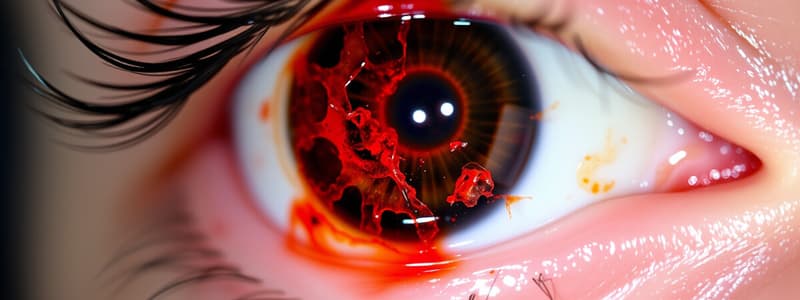Podcast
Questions and Answers
What is the most common cause of alkali burns?
What is the most common cause of alkali burns?
- Ammonium nitrate
- Sodium chloride
- Calcium hydroxide (correct)
- Potassium carbonate
Which of the following is an indicator of ischemia in alkali burns?
Which of the following is an indicator of ischemia in alkali burns?
- Pupil dilation
- Limbal blanching (correct)
- Conjunctival injection
- Corneal opacity
Which symptom is clearly associated with corneal abrasion?
Which symptom is clearly associated with corneal abrasion?
- Photophobia only
- Dry eye syndrome
- Foreign body sensation (correct)
- Increased intraocular pressure
What sign would you expect to find in a case of corneal abrasion?
What sign would you expect to find in a case of corneal abrasion?
Which of the following signs is associated with conjunctival abrasion?
Which of the following signs is associated with conjunctival abrasion?
What symptom is NOT typically associated with chemical ocular burns?
What symptom is NOT typically associated with chemical ocular burns?
Which type of burn generally has a worse prognosis?
Which type of burn generally has a worse prognosis?
Which of the following is considered a common alkali agent?
Which of the following is considered a common alkali agent?
Which sign on examination indicates ischemia in severe chemical burns?
Which sign on examination indicates ischemia in severe chemical burns?
What is the primary reason alkali burns are more common than acidic burns?
What is the primary reason alkali burns are more common than acidic burns?
Which of the following is NOT a sign of mild superficial punctate keratitis (SPK)?
Which of the following is NOT a sign of mild superficial punctate keratitis (SPK)?
Which acidic agent is often found in rust removers and glass polishers?
Which acidic agent is often found in rust removers and glass polishers?
Which symptom is least likely to result from chemical ocular burns?
Which symptom is least likely to result from chemical ocular burns?
What is most likely to occur if a hyphema obstructs the view of the fundus?
What is most likely to occur if a hyphema obstructs the view of the fundus?
Which type of hyphema fully fills the anterior chamber with blood?
Which type of hyphema fully fills the anterior chamber with blood?
What should a patient do to counter elevated intraocular pressure (IOP) due to blood accumulation?
What should a patient do to counter elevated intraocular pressure (IOP) due to blood accumulation?
What condition can occur in approximately 5% of patients with late stage hyphema?
What condition can occur in approximately 5% of patients with late stage hyphema?
Which sign is associated with approximately 60% of hyphema cases?
Which sign is associated with approximately 60% of hyphema cases?
What is the most common type of orbital fracture?
What is the most common type of orbital fracture?
Which symptoms are commonly associated with intraocular foreign bodies?
Which symptoms are commonly associated with intraocular foreign bodies?
Which materials are considered inert when present as intraocular foreign bodies?
Which materials are considered inert when present as intraocular foreign bodies?
What is an important laboratory test to consider for idiopathic hyphemas?
What is an important laboratory test to consider for idiopathic hyphemas?
What should NOT be ordered in suspected cases of metallic intraocular foreign bodies?
What should NOT be ordered in suspected cases of metallic intraocular foreign bodies?
Which condition significantly increases the risk of complications in idiopathic hyphemas?
Which condition significantly increases the risk of complications in idiopathic hyphemas?
Which sign is NOT associated with orbital fractures?
Which sign is NOT associated with orbital fractures?
Which demographic should be particularly screened for sickle cell disease in cases of idiopathic hyphemas?
Which demographic should be particularly screened for sickle cell disease in cases of idiopathic hyphemas?
What is the most likely type of foreign body causing a rust ring in the cornea?
What is the most likely type of foreign body causing a rust ring in the cornea?
Which symptom is NOT associated with a ruptured globe or penetrating ocular injury?
Which symptom is NOT associated with a ruptured globe or penetrating ocular injury?
Which sign is indicative of a positive Seidel's sign?
Which sign is indicative of a positive Seidel's sign?
What should NOT be performed within one month post-injury for a patient with hyphema?
What should NOT be performed within one month post-injury for a patient with hyphema?
Which demographic is most susceptible to ruptured globe injuries?
Which demographic is most susceptible to ruptured globe injuries?
What is the primary contributing factor for a hyphema?
What is the primary contributing factor for a hyphema?
Which non-metallic foreign body is the least likely to cause a rust ring in the cornea?
Which non-metallic foreign body is the least likely to cause a rust ring in the cornea?
What would you expect to observe in the anterior chamber of a patient with a ruptured globe?
What would you expect to observe in the anterior chamber of a patient with a ruptured globe?
What is a primary characteristic of Purtscher’s retinopathy?
What is a primary characteristic of Purtscher’s retinopathy?
What percentage of blunt ocular trauma cases typically results in a choroidal rupture?
What percentage of blunt ocular trauma cases typically results in a choroidal rupture?
Which sign is indicative of eyelid ecchymosis?
Which sign is indicative of eyelid ecchymosis?
Which test is important to perform when a conjunctival or corneal laceration is suspected?
Which test is important to perform when a conjunctival or corneal laceration is suspected?
What is a common risk associated with choroidal ruptures?
What is a common risk associated with choroidal ruptures?
What does prolapsed orbital fat often cause?
What does prolapsed orbital fat often cause?
Which of the following is NOT typically a cause of Purtscher’s-like retinopathy?
Which of the following is NOT typically a cause of Purtscher’s-like retinopathy?
What is the prognosis for a corneal laceration that does NOT involve the visual axis?
What is the prognosis for a corneal laceration that does NOT involve the visual axis?
What is a common consequence of an orbital wall fracture?
What is a common consequence of an orbital wall fracture?
What should be avoided in the first 48 hours after orbital trauma?
What should be avoided in the first 48 hours after orbital trauma?
What does a positive forced duction test indicate?
What does a positive forced duction test indicate?
Which symptom is most likely to be associated with commotio retinae?
Which symptom is most likely to be associated with commotio retinae?
What distinctive feature indicates an iridodialysis?
What distinctive feature indicates an iridodialysis?
What is the Vossius ring associated with?
What is the Vossius ring associated with?
What is a potential result of angle recession glaucoma following trauma?
What is a potential result of angle recession glaucoma following trauma?
What is an expected sign of commotio retinae?
What is an expected sign of commotio retinae?
Flashcards are hidden until you start studying
Study Notes
Chemical Burn
- Epidemiology: Most chemical ocular burns (66%) occur in industrial settings, involving exposure to chemical or thermal agents.
- Symptoms: Presentation includes normal or decreased vision, severe pain, foreign body sensation, photophobia, tearing, and blepharospasm.
- Signs: Corneal damage ranges from mild superficial punctate keratitis (SPK) to complete epithelial sloughing. Other signs include conjunctival injection, chemosis, anterior chamber reactions, and scleral blanching indicating ischemia.
- Pathophysiology: Alkali burns have worse outcomes than acidic due to elevated tissue pH and rapid penetration into cells. They are twice as common and are often more accessible.
- Common Alkali Agents: Include ammonia, lye, magnesium hydroxide, lime, and airbag residue.
- Common Acidic Agents: Include hydrofluoric acid, sulfuric acid, nitric acid, chromic acid, and PAVA spray.
- Limbal Blanching: Indicative of ischemia, especially prevalent in alkali burns.
Corneal Abrasion
- Epidemiology: Typically arises from trauma (e.g., fingernail, plant branch).
- Symptoms: Patients report sharp pain (especially on blinking), foreign body sensation, photophobia, tearing, and blurred vision.
- Signs: A corneal defect is observed with fluorescein staining, usually without underlying subepithelial infiltrate.
Conjunctival Abrasion
- Epidemiology: Often caused by similar trauma as corneal abrasions.
- Symptoms: Pain, foreign body sensation, and tearing are common.
- Signs: May exhibit conjunctival injection or subconjunctival hemorrhage.
Hyphema
- Epidemiology: Result of blunt or penetrating trauma; can also be idiopathic or linked to systemic diseases.
- Pathophysiology: Trauma to the iris or ciliary body leads to bleeding in the anterior chamber. Avoid gonioscopy soon after injury to prevent rebleeding.
- Symptoms: Include pain and blurred vision.
- Signs: Presence of blood in the anterior chamber, which can vary in color and extent.
Corneal and Conjunctival Superficial Foreign Bodies
- Epidemiology: Related to ocular trauma from foreign materials.
- Symptoms: Patients experience foreign body sensation, tearing, redness, and photophobia.
- Signs: Foreign bodies may be visible with or without surrounding sterile infiltrates. Rust rings can indicate metallic foreign bodies.
Ruptured Globe and Penetrating Ocular Injury
- Epidemiology: More frequent in males, especially young and middle-aged.
- Symptoms: Include pain, blurred vision, redness, photophobia, and tearing.
- Signs: Indicative signs include full-thickness laceration, severe conjunctival hemorrhage, low intraocular pressure (IOP), and positive Seidel's sign.
Intraocular Foreign Body
- Epidemiology: Typically due to trauma, particularly from high-speed impacts.
- Symptoms: Pain and decreased vision are common complaints.
- Signs: Imaging may reveal foreign bodies along with iris transillumination defects and other ocular injuries.
Orbital Fracture
- Epidemiology: Often results from trauma from blunt objects.
- Pathophysiology: Orbital floor fractures are the most prevalent due to the weakness of the maxillary bone.
- Symptoms: Include pain and diplopia.
- Signs: Vary by fracture site; can lead to visible subconjunctival hemorrhage and enophthalmos.
Commotio Retinae
- Epidemiology: Associated with recent ocular trauma.
- Pathophysiology: Results from disruption of retinal pigment epithelium and outer segments of photoreceptors.
- Symptoms: Typically asymptomatic, but may cause acute vision loss if the macula is involved.
- Signs: Gray-white discoloration of the retina; associated retinal hemorrhages may occur.
Iridodialysis
- Caused by disinsertion of the iris root from the ciliary body; may pose a risk of angle-recession glaucoma.
Purtscher’s Retinopathy
- Occurs often with chest compressing trauma and is characterized by retinal hemorrhages and cotton wool spots.
Choroidal Rupture
- Occurs in 5-10% of blunt ocular trauma cases, presenting as a subretinal hemorrhage near the optic nerve with a risk of developing neovascularization.
Eyelid Ecchymosis
- Also known as "black eye," results from trauma and can indicate underlying ocular damage.
Conjunctival and Corneal Lacerations
- Tears in the corneal or conjunctival tissue following trauma; should undergo Seidel's test to check for open globe wounds.
Prolapsed Orbital Fat
- Aging weakens the orbital septum, causing soft out-pouches of fat in eyelids that are generally asymptomatic but may lead to cosmetic issues.
Studying That Suits You
Use AI to generate personalized quizzes and flashcards to suit your learning preferences.




